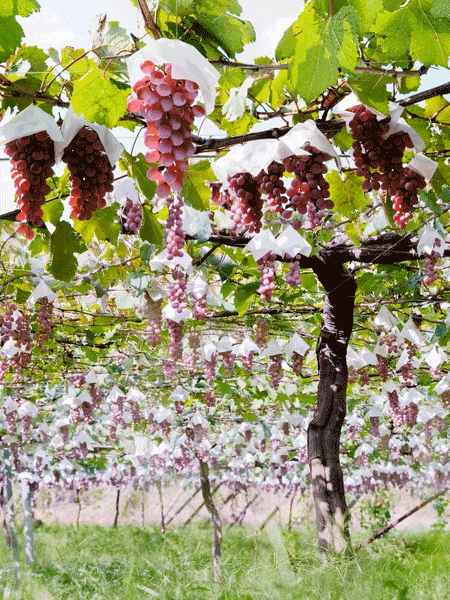There is something distinctly Japanese about Japan’s native Koshu grape
Japan between vines
With an estimated 1,000 year history of cultivation, Koshu is Japan’s oldest grape variety. The fame of the Koshu grape has grown gradually as Koshu wine tends to heighten the natural flavours of the Japanese cuisine.

Someone must have told me about the Koshu grape or I must have read about it. In either case, I had not paid attention. I came on the grape again when looking through notes I made in a masterclass about Japanese wines a few years ago. My curiosity got the best of me. I wanted to know more about Koshu, this under the radar grape believed to have arrived in Japan via the Caucasus some 1000 years ago.

Koshu has a long history in Japan
The Koshu grape can date its history in Japan as far back as 1186 AD.
At the time it was recorded as growing wild in Katsunama, located in the Yamanashi prefecture. A farmer replanted the vine on his land and thus began cultivating what is known now as the forerunner of the Koshu grape.
The vine was not native to the land, suggesting that its ancestor might have been imported from somewhere in Europe. DNA analysis at the University of California at Davis demonstrated that the Koshu variety is a crossing of circa 70% Vitis vinifera with other Asian varieties, var. Orientalis.

Gyoki’s dream
There is even an older story, a story about a grape-growing Buddhist monk Gyogi. Gyoki had a dream about the Buddha of Medicine, Yakushi Nyorai while visiting the Koshu Valley in Japan. In the dream, Yakushi Nyora held a bottle of medicine in one hand and a cluster of grapes in the other. To honour Yakushi Gyogi began construction on the Daizen-Ji temple in Katsunuma, near Kofu, around 718 AD. Gyoki discovered a grapevine while carving the original statue of Yakushi Nyora to be inshrined in the new temple. Gyoki saw this as a sign to start growing grapes for medical purposes. A copy of the original statue of Yakushi Nyora still stands in the main hall of the Daizen-Ji or the “grape temple” as it is locally known.

Two-way grape
For a long time, the Koshu grape was mainly eaten as a fresh table grape.
Although there were local farmers throughout the Koshu valley, who collected the fallen and damaged grapes to ferment them adding generous amounts of sugar to make Koshu wine. In that sense Koshu is a two-way grape, it can be eaten fresh or fermented into wine.
On a larger scale, the Koshu grape only started to play a role in Japanse winemaking after the 1870s when in August 1877 the first private winemaking company, the Dai-Nihon Yamanashi Budoshu Gaisha (later Château Mercian), was founded in Katsunuma. In October of the same year two young men, Masanari Takano and Ryuken Tsuchiya, travelled to France to learn winemaking techniques. After returning to Japan in May 1879, they started to produce wines with the local Koshu grapes.

The Koshu grape does well in Japan
Although many grapes are grown in Japan, wineries in Yamanashi, the most important of Japan’s four major wine regions, are focusing on the native Koshu grape as its star variety. Koshu excels in Japan’s rainy, humid conditions due to its naturally thick skin and its high resistance to disease. Koshu is a late-maturing grape variety. The grapes have an aromatic character a bit similar to Sauvignon Blanc.
Most vines in Japan are grown on slopes, between 350-700 meters altitude, given the fact that this was the only cultivable land on which rice couldn’t grow. In the past a special training system called “Itimonnji Tansyo” was common. This pergola method keeps one or two long branches extended along horizontal bamboo trellises to maximise airflow.
Now, most vineyards use a European style horizontal trellis. Horizontal trellises utilise the sunshine more efficiently, minimise the spread of diseases. And, minimise wind damage. Very important, since most of the grape-growing areas are hit by typhoons almost every year.

Tasting Koshu wines
Koshu wines are pale in colour, subtle, with delicate aromas of roses, yuzu, pink grapefruit, white peach and some melon. On the palate a fresh acidity, Japanese citrus, lemons, limes, green plums and often a distinct minerality. The wines are fresh, restrained and balanced, generally low in alcohol, with a clean, crisp and polished finish, making them an obvious choice for subtly flavoured dishes and a brilliant wine match for the flavours in Japanese cuisine.
At the masterclass, someone explained it like this: Koshu wine contains fewer amounts of iron or organic acid chloride, the substances that make par example fish smell a little bit stronger. That’s the reason why Koshu wines pair perfectly with fresh seafood, sushi, sashimi, light meats and vegetables.

The Koshu grape linked to the Japanse cuisine concept of ‘Washoku’
The Koshu grape is inextricably linked to the re-birth of the Japanese wine industry. Aside from being Japan’s oldest grape variety, it also became Japan’s top variety, with many types of Koshu wines available. Wines made with the sur-lie method, or a style with more citrusy notes. There are fuller, more rounded wines as well, fermented or aged in oak barrels, Then there are wines made by leaving grape skins and seeds in the juice to produce orange wines with a dry, stony texture and sharp citrus, zesty edge. And one can drink sparkling Koshu wines too. In 2010, the Koshu grape was registered on the list of grape varieties recognized by the International Organization of Vine and Wine (OIV).
Koshu wine is now being promoted globally linked to the concept of ‘Washoku’ (Japanese cuisine or Japanese taste). Washoku can be anything from a traditional dish to a full-blown meal with wine. Washoku revolves around respect for Japan’s natural bounty. It’s about preparing a meal in a way that maximizes the natural flavour of the ingredients as much as possible to satisfy all the senses.
In 2013, UNESCO added Washoku to its list of Intangible Cultural Heritage. The delicate Koshu wines with their fresh, acidic, umami palates have been re-branded as “Japanese Heritage”. This not only helps to raise the consumption of local wines in the domestic market, by creating a sense of place and Japanese identity but also awareness about Koshu wines worldwide. There is a subtlety to Koshu wines, a quiet quality that takes you on a journey to the aromas of Japan. Just go along with the flow.


